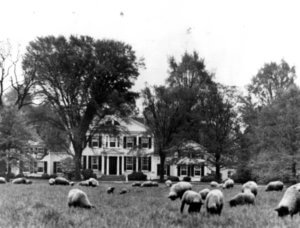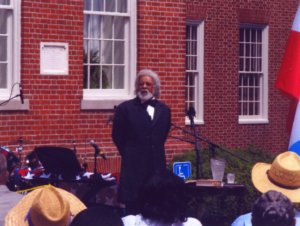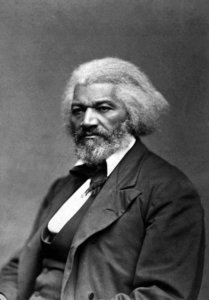Frederick Douglass, original name Frederick Augustus Washington Bailey, was born a slave February 1818 in Talbot County, MD on Tuckahoe Creek near what is now called Cordova. Separated as an infant from his enslaved mother, he lived with his grandmother on a Maryland plantation until, at age eight, his owner sent him to Baltimore to live as a house servant with the family of Hugh Auld.
As a boy, Douglass realized the importance of education, especially after his master forbade the reading lessons that Hugh Auld’s wife, Sophia, had begun to give him. Douglass obtained a copy of “The Columbian Orator” and secretly taught himself to read and write. Through his education and later conversion to religion, the yearning within Douglass to be a free man was heightened. In Baltimore, Douglass met many free blacks, including Anna Murray, whom he married in 1838. That was the year Douglass fled Baltimore to escape slavery.

Possibly the Wye House located on the Wye River with sheep grazing in the front yard. This is the famous ancestral home of the Lloyd family where Frederick Douglass was a slave as a child. Photo by H. Robins Hollyday.
After escaping slavery in Maryland, he settled in Massachusetts, where he changed his surname to Douglass. He became a leader of the abolitionist movement in Massachusetts, New York and beyond and later catapulted to a number of other positions of local and national influence. Throughout his life, memories of his own whippings, beatings, and basic denigration as a slave and as a free man were included in his oratory and published texts. He worked tirelessly for the equal treatment of all races and genders. In 1878, Douglass returned to Easton, MD and spoke at the Courthouse, Asbury United Methodist Church, and Bethel A.M.E. Church. By the end of his life, Douglass had served as adviser, political ally, and friend to six USA presidents, abolitionists Gerrit Smith and William Lloyd Garrison; women’s rights activists Susan B. Anthony, Elizabeth Cady Stanton, and Lucretia Mott; and authors Samuel Clements (Mark Twain) and Ralph Waldo Emerson.
Douglass died February 1895, both nationally and internationally acclaimed as one of the most influential men of his century.

Photo of a historical actor, Fred Morsell, portraying Frederick Douglass at “Douglass Returns, The Dedication” on the Talbot County Courthouse lawn. He performed “A soul’s evolution – Frederick Douglass on race.”
In conjunction with the Talbot County Office of Tourism, the Talbot Historical Society produced a driving tour guide of sites in Talbot County associated with Frederick Douglass.
In 2011, a statue honoring Douglass was installed on the Talbot County Courthouse lawn in Easton, MD. The statue was sculpted by Jay Hall Carpenter, and represents when Douglass returned to Talbot County in 1878, this time as a free man, and gave a speech at the courthouse. The statue was organized by the Frederick Douglas Honor Society, as well as a four day celebration leading up to the unveiling.
Further Reading
Frederick Douglass’s autobiographical work and other writings are acclaimed for their depictions of the harsh reality of enslaved life, and are well worth the read if you have not picked them up. Many of these works can be read for free online.
- Narrative of the Life of Frederick Douglass (1845 memoir)*
- My Bondage and My Freedom (1855 autobiography)*
- Life and Times of Frederick Douglass (1881 autobiography)*
- The Heroic Slave (1852 fiction novella)
- What to the Slave is the Fourth of July? (1852 speech)
- This July NPR released a video of Douglass’s descendants reading and discussing this speech.
- Self-Made Men (1872 speech)
- The North Star (1847-1851 newspaper)
Some of Douglass’s other papers are available to view through the Library of Congress. This includes personal correspondence, diaries, speeches, and more.
There have also been many biographies and pieces of scholarship written about Douglass. Asterisks denote which books are in the THS Research Library.
- Frederick Douglass: Prophet of Freedom by David W. Blight (2018)
- Facing Frederick: The Life of Frederick Douglass, a Monumental American Man by Tonya Bolden (2018)
- Frederick Douglass and the Fourth of July by James A. Colaiaco (2006)*
- Women in the World of Frederick Douglass by Leigh Fought (2017)
- There Was Once a Slave: The Heroic Life of Frederick Douglass by Shirley Graham (1947)*
- Frederick Douglass by William S. McFeely (1990)
- Young Frederick Douglass: The Maryland Years by Dickson J. Preston (1980)*
- Frederick Douglass edited by Benjamin Quarles (1951)*
- Frederick Douglass by Booker T. Washington (1969)
- Picturing Frederick Douglass: An Illustrated Biography of the Nineteenth Century’s Most Photographed American (2015)
- For a list of even more suggested readings, check out this page from the National Parks Service.
Web Resources
- Frederick Douglass Birthplace
- This site contains a timeline of Douglass’s life in Talbot County, driving tours of important sites, and readings.
- Frederick Douglass Honor Society
- A Talbot County organization focused on “developing programs that continue the Douglass legacy of human rights, education, personal growth, and involvement of citizens.”
- Frederick Douglass National Historic Site
- This NPS site while currently closed to the public, has a virtual tour of Frederick Douglass’s house, as well as many online programs this month.
- Frederick Douglass Family Initiatives
- Founded by direct descendants of Frederick Douglass and Booker T. Washington, this NY non-profit is focused on racial equality and the end of human trafficking and other exploitation.
Sources
This biography was written by THS board member Dr. Willie Woods for our African American Room exhibit.
